COMPARATIVE PERSPECTIVES ON SCOTTISH W RITING
COMPARATIVE PERSPECTIVES ON SCOTTISH W RITING
COMPARATIVE PERSPECTIVES ON SCOTTISH W RITING
Create successful ePaper yourself
Turn your PDF publications into a flip-book with our unique Google optimized e-Paper software.
How do you see Trainspotting in relation to this process, and this ideology<br />
3. What kinds of ‘knowable communities’ are in this book Are they specifically Scottish British<br />
‘Western’ Consumerist Something else<br />
4 Mar<br />
Set Reading:<br />
Selby, Hubert, Jr., 1968. Last Exit to Brooklyn, London: Boyars<br />
Demotic Language and Narration: short extracts from William McIlvanney, Docherty (1975) and Lewis<br />
Grassic Gibbon, Sunset Song (1932)<br />
Interview:<br />
O’Brien, John 1981. ‘An Interview with Hubert Selby’, Review of Contemporary Literature [full interview<br />
at http://dalkeyarchive.com/interviews/620/hubert-selby-2]<br />
Film Screening:<br />
Last Exit to Brooklyn, dir. by Uli Edel, (1989) – Mar 3, 4.30pm, Pathfoot B2<br />
Tasks<br />
1. In 1831 Thomas Carlyle wrote of the London populace: ‘There in their little cells, divided by partitions<br />
of brick or board, they sit strangers … It is a huge aggregate of little systems, each of which is again a small<br />
anarchy, the members of which do not work together, but scramble against each other.’ Is this a fair<br />
description of the urban world depicted in Last Exit<br />
2. Does the novel encourage us to judge, and even condemn, these characters If so, how By what/whose<br />
standards<br />
3. How does using a non-standard language as the voice of the authorial narrative (as in the Grassic<br />
Gibbon extract) differ from reserving it for characters’ dialogue (as in the McIlvanney extract) How does<br />
Selby’s technique compare to these examples<br />
4. Compare the use of vernacular language in Last Exit with Welsh’s techniques in Trainspotting. What<br />
similarities do you see What differences What is the overall effect<br />
Recommended Further Reading – Weeks 2-3:<br />
Bell, Ian 1993. ‘Last exit to Leith’, Observer (15 August 1993), 47 [use Lexis-Nexis, via elec. resources<br />
page]<br />
Crowley, Tony 2003. Standard English and the Politics of Language, 2nd edn., Basingstoke: Palgrave<br />
Macmillan*<br />
Findlay, Elspeth 2002. ‘The bourgeois values of Irvine Welsh’, Cencrastus, 71, 5-6<br />
Freeman, Alan 1996. ‘Ghosts in Sunny Leith: Irvine Welsh’s Trainspotting’, in Studies in Scottish Fiction:<br />
1945 to Present, ed. by Suzanne Hagemasdnn, Frankfurt: Peter Lang, 251-62<br />
Innes, Kirstin 2007. ‘Renton’s Bairns: Identity and Language in the post-Trainspotting novel’ in Edinburgh<br />
Companion to Contemporary Scottish Literature, ed. by Berthold Schoene, Edinburgh: Edinburgh<br />
University Press, 301-310*<br />
Jamieson, Gill 1997. ‘Fixing the city: arterial and other spaces in Irvine Welsh’s fiction’, in Space and<br />
Place: the Geographies of Literature, ed. by Glenda No rquay and Gerry Smyth, Liverpool: John<br />
Moores University Press, 217-26<br />
Kelly, Aaron 2005. Irvine Welsh, Manchester: Manchester University Press*<br />
5



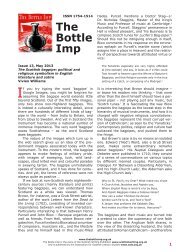
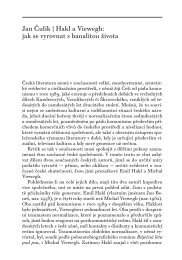
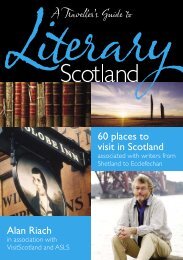
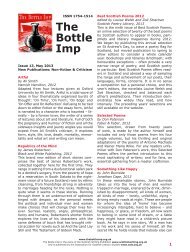
![IPA Index 1 People - E © M K C MacMahon 2007 E, [ ]: 1900.févr ...](https://img.yumpu.com/46502562/1/190x245/ipa-index-1-people-e-ac-m-k-c-macmahon-2007-e-1900facvr-.jpg?quality=85)
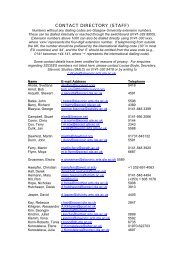
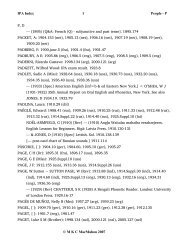
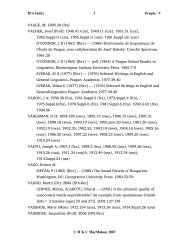
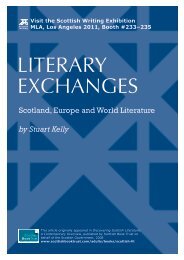
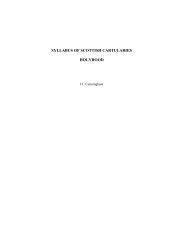
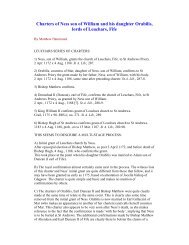

![IPA Index 1 People - D © M K C MacMahon 2007 D, [ ]: 1900.févr ...](https://img.yumpu.com/9908389/1/190x245/ipa-index-1-people-d-c-m-k-c-macmahon-2007-d-1900fevr-.jpg?quality=85)
